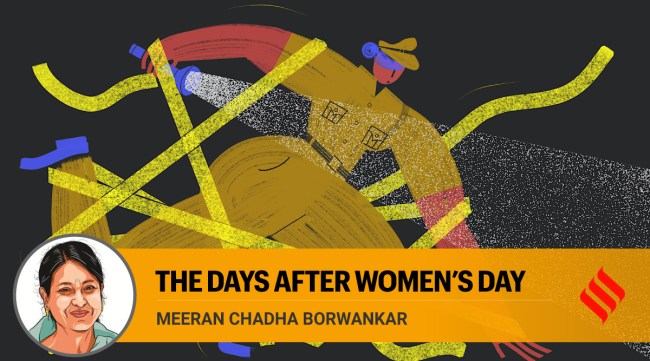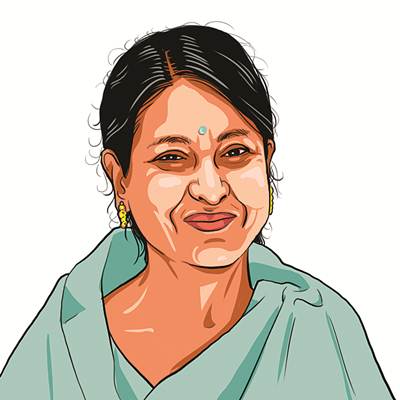Opinion The days after Women’s Day: Integrate women cops as leaders in the police force
We celebrated the induction of women in uniform. Now we cannot allow them to stagnate
 An area of concern is the hostility that women police officers face during pregnancy and post their maternity leave. (Illustration: C R Sasikumar)
An area of concern is the hostility that women police officers face during pregnancy and post their maternity leave. (Illustration: C R Sasikumar) Gender empowerment has been a popular theme in India and some tangible policy decisions have indeed been made. Encouraging women to don the uniform is one such initiative. Most states and Union Territories in India have reservation for women in police and as per data released by the Bureau of Police Research & Development, they are now around 10.49 per cent of the strength of the total police force in the country (2021).
The uniform has been a powerful symbol in a society that has relegated its girls to a secondary position. However, the rise has been only on the surface. Scratch it and the tendency seen in recent cases of murder of Shraddha Walkar, Nikki Yadav and Megha Torvi continues unabated. All this, while we routinely celebrate “Women’s Day” in different forums.
This is not to undervalue the idea of inducting women in police, paramilitary and armed forces but to suggest that much more is needed to enable them to fulfil their full potential and for the community to gain from their presence. One had thought that women in uniform would send a strong positive signal but the ground reality continues to be bleak. Crime against women is very high with abysmal rate of conviction. Public spaces are still unsafe, especially after dark, curtailing their free movement and thus adversely affecting their working hours and employment avenues.
Policy alone is not sufficient to strengthen the hand that holds the baton. While women must make individual efforts to develop their professional skills, there has to be commitment from the field-level leadership too. Coaching in communication skills and fruitful negotiations during public disorder can help them deal with the different types of conflicts they face. Women officers can work on their time management skills, financial literacy and networking to attend to diverse professional and personal responsibilities.
In most states, there is hardly any in-service training post their induction, though laws keep getting amended and new ones get added. Female police officers are expected to investigate crime against women and cases under Protection of Children from Sexual Offences Act 2012 (POCSO Act) but in many states, they have not received any specialised training for the same. Local law colleges and universities can be approached for understanding the latest amendments and provisions of law.
A study at the Centre for Police Research, Pune, during 2015-16 showed that though their number is increasing in Maharashtra Police, yet women officers do not receive the required cooperation from male colleagues. It shows the importance of sensitising men on women in police stations and the need to respect them as professional colleagues instead of resenting their presence. Female officers who responded in the study flagged the need for training in leadership and regular interactive sessions. Studies conducted in Australia and Britain too suggest that merely increasing the number of women police officers does not lead to gender friendliness and cooperation in the department.
Another area of concern is the hostility that women police officers face during pregnancy and post their maternity leave. In a career that generally spans more than three decades, there are a few intervals when women need to slow down due to physical and medical constraints. If society accepts that we must have more women in the work force then menstruation and child-bearing stages in a woman’s career should also be accepted naturally without casting aspersions on their capabilities. This requires sensitivity. Instead of considering women as imposters, the department should construct rest rooms, changing rooms and creches for them.
Let’s bid goodbye to All Women Police Stations (AWPSs) and take a step forward to an inclusive world where complainants, irrespective of gender, will get prompt redressal of their grievances. A standard police station must reflect the healthy gender ratio of society. Its main objectives are prevention and detection of crime and maintenance of public order. That only women acting as “matrons” can do justice to the issues of women is an idea that can be discarded now. Women have proved competent to deal with complex issues while men have proved to be compassionate and empathetic to women victims. Confining them to All Women Police Stations or to investigation of offences against women and children only is a gross under-utilisation of their wide-ranging capabilities. It is also unjust for women victims who are made to travel long distances in search of AWPSs. A 2020 study published by Cambridge University Press about ‘All Women Police Stations of Haryana’ concluded that they may have unintended consequences, for instance, “counselling” of victims by encouraging reconciliation with abusers at the expense of arrest of suspects, and increased travel cost for victims seeking redress.
A recent comparative study of women in police in China and the US by Anqi Shen of Northumbria University, United Kingdom and Dorothy Moses Schulz of John Jay College of Criminal Justice, United States, concluded that while women police in the US have been integrated, women police in China attend to mainly indoor administrative and support duties. Unlike in India, they are rarely involved in mainstream policing with policemen as partners and “are dubbed as ‘police flowers’ because of their perceived femininity and differing roles”. Women police in India, however, prefer integration and leadership roles to being “police flowers”.
We celebrated the induction of women in uniform and we cannot allow them to stagnate. The next step forward is to mainstream them and use their full potential for their own satisfaction as also for the good of society. Appropriate physical infrastructure, level playing field, gender sensitivity and opportunities to continuously upgrade their skills are needed for developing them as authentic professionals. From being considered imposters, to matrons, and “flowers” to finally being accepted as capable and skilled leaders is the journey of the women police that needs to be celebrated on the days after Women’s Day.
The writer, a retired IPS officer, was Director General, Bureau of Police Research and Development






